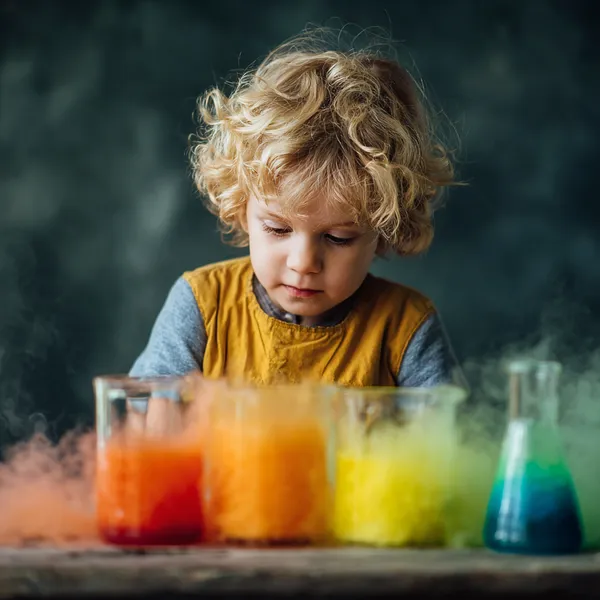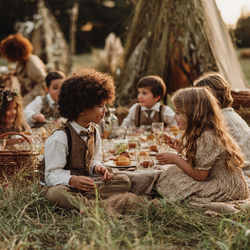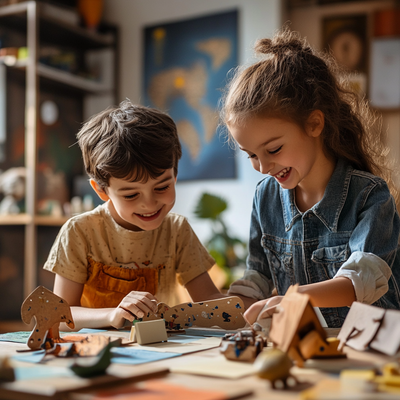So I'm trying to teach about God creating the world and the kids are just staring at me like I'm speaking ancient Greek or something.
Marcus is picking at his shoe. Emma's braiding her friend's hair. Tyler's making weird faces at the ceiling.
I'm going through my usual creation lesson with pictures and stories and they're just completely checked out.
Finally I stop mid-sentence and go "You know what? Let's just make a volcano."
Suddenly every head in the room snaps up. "A volcano? Like a real one that explodes?"
"Well not exactly real but yeah it'll explode."
And just like that I had their complete attention for the first time all morning.
Turns out kids love science experiments way more than they love me talking about science. Who knew, right?
Started incorporating simple experiments into lessons and it's been a total game changer. Kids actually get excited about learning instead of just enduring it.
Baking Soda Volcano Obviously
This one's a classic for good reason. Kids absolutely lose their minds over it every single time.
Get an empty water bottle. Make a cone around it with play dough or clay or even just dirt if you're doing it outside.
Put a few tablespoons of baking soda in the bottle. Add a drop of food coloring if you want it to look more lava-like.
Mix vinegar with a little bit of dish soap in a separate cup. Pour it in the bottle and step back.
Foam comes shooting out and kids go absolutely wild. Cheering and wanting to do it again immediately.
Perfect for creation lessons about God making mountains and volcanoes. Or lessons about the power of God. Or honestly any lesson because kids just love watching things explode.
Marcus who was completely zoned out five minutes earlier? Now he's asking if we can make a bigger volcano next time and what would happen if we used more baking soda.
Dancing Raisins Thing
This one looks like actual magic to little kids.
Get clear soda like Sprite or club soda. Drop some raisins in and watch what happens.
Raisins sink to the bottom then mysteriously float back up to the top then sink again. Over and over like they're dancing.
Kids are convinced you did some kind of trick. They're checking the cup for strings or magnets or whatever they think is making raisins move.
Great for lessons about God's power being mysterious or how God can do things we don't understand.
Plus it's super simple and doesn't make a huge mess which is always a bonus.
Magic Milk Colors
Pour some milk in a plate. Add a few drops of different colored food coloring in different spots around the edge.
Get a cotton swab and dip the tip in dish soap. Touch the soapy tip to one of the food coloring drops.
Colors start swirling and moving like they're alive. Kids think it's actual magic happening.
Can talk about how God makes beautiful things. Or how God brings order out of chaos. Or just let kids be amazed by colors dancing around.
Emma who never pays attention was mesmerized by this one. Kept asking to do it again with different colors.
Growing Crystals
Mix hot water with lots of salt or sugar until no more will dissolve. Hang a string in the solution and wait.
Over the next few days crystals start growing on the string. Kids check on it obsessively wanting to see progress.
Takes patience which is a good lesson in itself. But the result is actually pretty amazing.
Can connect to lessons about how God grows things slowly. Or how God creates beautiful things over time. Or just talk about how awesome science is.
Kids love having something to check on and watch change over time.
Invisible Ink
Dip a cotton swab in lemon juice and write a message on white paper. Let it dry completely so you can't see anything.
Hold paper near a light bulb or warm iron and writing magically appears.
Kids love secret messages and thinking they're spies or whatever.
Good for lessons about how God sees things we can't see. Or how God reveals truth to us. Or stories about secret messages in the Bible.
Tyler who usually disrupts everything was totally focused trying to write his own invisible messages.
Static Electricity Hair
Blow up a balloon and rub it on someone's hair or a fuzzy sweater for like thirty seconds.
Hold the balloon near small pieces of paper or hair and watch them jump toward the balloon like magic.
Kids love volunteering to be the one whose hair stands up when you hold the balloon near their head.
Simple but demonstrates power we can't see which connects well to lessons about God's power being invisible but real.
Also just fun and gets kids laughing which sometimes is exactly what you need.
Rainbow Paper Chromatography
Get coffee filters and cut them into strips. Color a heavy line with washable marker near the bottom of the strip.
Hang the strip in a cup with a little bit of water so just the very bottom touches water.
Watch as water travels up the paper and separates the marker ink into different colors.
Black marker turns into blues and yellows and reds. Green marker separates into blues and yellows.
Kids are amazed that one color is actually made up of many colors hidden inside.
Perfect for lessons about how God sees more than we can see. Or how things aren't always what they appear to be.
Density Tower
Get honey, corn syrup, dish soap, water with food coloring, and vegetable oil.
Slowly pour each liquid into a tall clear container starting with the heaviest.
If you're careful they stack on top of each other in layers instead of mixing together.
Kids can't believe liquids can stack like that. They want to stick their fingers in to see if it's real.
Drop small objects like grapes or coins and watch them stop at different layers depending on their density.
Great for talking about how God created order in the world. Or how everything has its place in God's plan.
Simple Circuit
Get a battery, wire, and small light bulb. Show kids how to connect wire from one end of the battery to the light bulb and back to the other end of the battery.
Light bulb lights up and kids think you're an electrical genius.
Let them try making their own circuits. Some figure it out immediately, others need help, but everyone gets excited when their light works.
Can talk about how God gives us the power we need. Or how we need to be connected to God like wire needs to be connected to a battery.
Also teaches basic problem solving and following directions.
What Makes These Actually Work
Kids learn way better when they can touch and see and do instead of just listen.
Experiments feel like play, not like school, which means kids actually pay attention.
There's an element of surprise and wonder that makes lessons memorable.
Kids ask better questions when they're curious about what's happening.
Even kids who struggle with sitting still can participate actively.
Failures and mistakes become learning opportunities instead of disasters.
Keeping It Simple
Don't need fancy equipment or expensive supplies. Most of these use stuff you probably have lying around.
Choose experiments that actually work reliably. Nothing worse than hyping kids up for something that flops.
Practice beforehand so you know what to expect and can troubleshoot problems.
Have a backup plan in case the experiment doesn't work or finishes faster than expected.
Keep groups small enough that everyone can see what's happening.
Making Lessons Interactive
When looking for Sunday School Lessons that include hands-on activities instead of just lectures, some resources get it way better than others.
Found VBS: On the Case recently - detective theme that includes investigation activities and experiments built right into the lessons. Type of curriculum where hands-on learning is part of the design, not just an add-on you have to figure out yourself.
Safety Stuff Obviously
Always supervise when using anything hot or electrical or potentially messy.
Test experiments yourself first to make sure they're actually safe for your age group.
Have paper towels and cleanup supplies ready because messes will happen.
Set clear boundaries about what kids can and can't touch.
Choose experiments appropriate for your space and situation.
Connecting to Bible Lessons
Don't force connections that don't make sense. Sometimes an experiment is just fun and that's okay.
Let kids make their own connections first before you explain what you think it means.
Use experiments to start conversations, not to prove specific points.
Remember the goal is engagement and wonder, not perfect theological metaphors.
Some of the best discussions happen when kids ask questions you weren't expecting.
What I've Learned
Kids remember lessons with experiments way longer than lessons with just talking.
Even simple experiments create a sense of wonder that opens kids up to bigger questions about God and life.
Hands-on activities work for all different learning styles, not just visual learners.
Kids who never participate in discussions suddenly have opinions and questions when they've done an experiment.
Parents love hearing about science experiments almost as much as kids love doing them.
My Current Go-To Experiments
Volcano for any lesson where you need to grab attention and create excitement.
Dancing raisins when you want something simple that looks like magic.
Magic milk when you have time for mess and want something visually stunning.
Static electricity for quick demonstration that doesn't require preparation.
Invisible ink when lesson involves secrets or hidden things.
Why I Keep Doing These
Marcus went from completely disengaged to asking science questions during car rides home.
Kids started paying attention to science stuff in the world around them instead of just ignoring it.
Parents tell me kids are trying experiments at home and teaching siblings what they learned.
Even shy kids participate because they're curious about results, not worried about giving wrong answers.
Creates natural opportunities to talk about how amazing God's creation is.
Gets kids excited about learning instead of just enduring it.
Makes abstract concepts concrete in ways kids can actually understand.
That's worth dealing with occasional messes and chaos in my opinion.
Watch YouTube
Listen to Podcast








